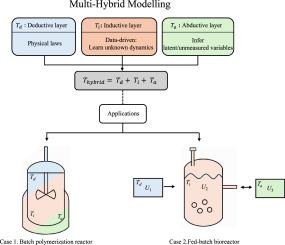化学过程的混合建模:基于演绎、归纳和溯因推理的统一框架
IF 3.9
2区 工程技术
Q2 COMPUTER SCIENCE, INTERDISCIPLINARY APPLICATIONS
引用次数: 0
摘要
混合建模为复杂的化学过程提供了将机械原理与数据驱动学习相结合的强大手段。然而,大多数现有的方法依赖于结构耦合,而没有集成不同的推理模式或支持模块化重用的原则基础。这项工作引入了一个统一的分层混合建模架构,该架构基于三个认知层:演绎、归纳和溯因。每一层的作用是:执行物理定律,学习未知动态,推断潜在状态。这个公式是用算子理论的术语来表示的。结果表明,该框架的准确性、可解释性和适应性得到了提高,突出了该框架作为化学过程系统不确定性下混合建模的透明和可推广策略的潜力,同时也支持组合推理和分层再训练。第一个案例研究考虑了一个反应动力学和部分温度可观测性未知的单单元非等温间歇聚合反应器。演绎层编码质量和能量平衡,感应层通过神经网络学习动力学,外展层重建潜在温度状态。第二个案例研究考察了一个多单元进料间歇生物反应器流程,代表了典型的化学过程配置。在这里,演绎层模拟饲料流动动力学(单元1),诱导层预测生物量增长(单元2),外展层估计潜在的生理状态,如摄氧量和pH值(单元3)。这些例子表明,该框架可以在单个单元中集成多个推理模式,或者将它们分布在流程图中,从而使应用程序能够广泛地混合建模场景。该方法具有通用性,适合于不确定条件下可扩展的透明建模。本文章由计算机程序翻译,如有差异,请以英文原文为准。

Hybrid modelling of chemical processes: a unified framework based on deductive, inductive, and abductive inference
Hybrid modelling offers a powerful means of combining mechanistic principles with data-driven learning for complex chemical processes. However, most existing approaches rely on structural coupling without a principled basis for integrating distinct modes of reasoning or enabling modular reuse. This work introduces a unified layered hybrid modelling architecture grounded in three epistemic layers: deductive, inductive, and abductive. Roles of each layer are: enforcing physical laws, learning unknown dynamics, and inferring latent states. The formulation is expressed in operator-theoretic terms. Results demonstrate improved accuracy, interpretability, and adaptability, highlighting the framework’s potential as a transparent and generalizable strategy for hybrid modelling under uncertainty in chemical process systems, while also supporting compositional reasoning and layer-wise retraining.
The first case study considers a single-unit non-isothermal batch polymerization reactor with unknown reaction kinetics and partial temperature observability. The deductive layer encodes mass and energy balances, the inductive layer learns kinetics via a neural network, and the abductive layer reconstructs latent temperature states. The second case study examines a multi-unit fed-batch bioreactor flowsheet, representative of typical chemical process configurations. Here, the deductive layer models feed-flow dynamics (unit #1), the inductive layer predicts biomass growth (unit #2), and the abductive layer estimates latent physiological states such as oxygen uptake rate and pH (unit #3). These examples demonstrate that the framework can integrate multiple inference modes within a single unit or distribute them across a flowsheet, enabling application to a wide range of hybrid modelling scenarios. The approach is general and suited for scalable, transparent modelling under uncertainty.
求助全文
通过发布文献求助,成功后即可免费获取论文全文。
去求助
来源期刊

Computers & Chemical Engineering
工程技术-工程:化工
CiteScore
8.70
自引率
14.00%
发文量
374
审稿时长
70 days
期刊介绍:
Computers & Chemical Engineering is primarily a journal of record for new developments in the application of computing and systems technology to chemical engineering problems.
 求助内容:
求助内容: 应助结果提醒方式:
应助结果提醒方式:


